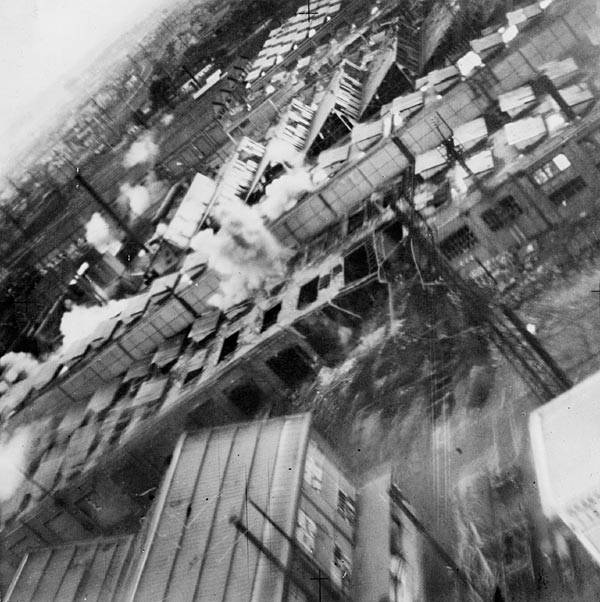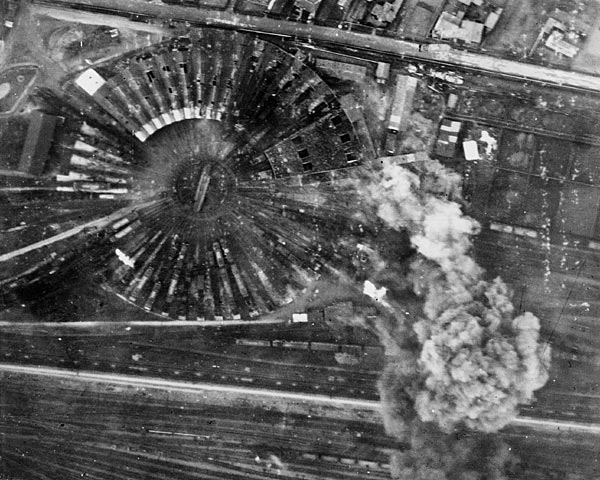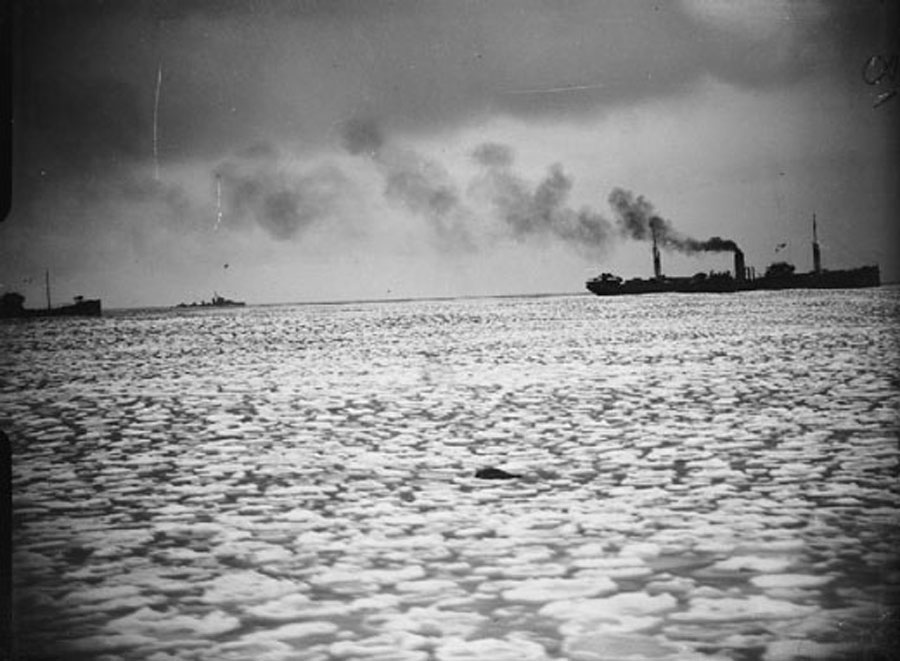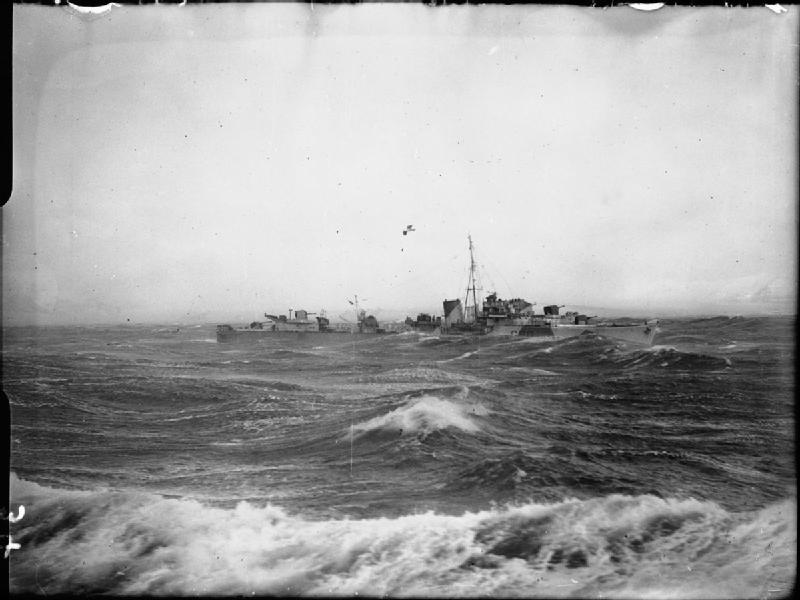Air Operations, Aleutians
6 A6M2-N 'Rufe' figher bombers attack the runway of the airfield at Amchitka.
[Air Operations, Bismarcks
43rd Heavy Bomb Group B-17s attack Rabaul, shipping in the harbor, and the Rapopo airfield at Rabaul.
[Air Operations, CBI
BURMA- 7th Heavy Bomb Group B-24s attack the bridge at Myitnge.
Air Operations, East Indies
- 90th Heavy Bomb Group B-24s attack shipping and the town area at Amboina Island.
- V Bomber Command B-25s attack Dili and the Dili airfield on Timor.
Air Operations, Europe
BOMBER COMMANDDaylight Ops:
- 23 Bostons attack Dunkirk harbor claiming hits on ships. 12 Mosquitos bomb the railway workshops at Tours.
- There are no losses.
|
|
- 6 Oboe Mosquitos bomb Essen, Rheinhausen ahd the German night-fighter airfiels at St Trond. A map from Essen shows the bombs dropped there hit the southern part of the Krupps factory. 4 Stirlings lay mines in the Gironde River and 2 OTU Wellingtons drop leaflets over France.
- There are no losses.
Air Operations, New Guinea
- V Bomber Command B-25s attack supply dumps at Malahang.
- 90th Heavy Bomb Group B-24s mount single-plane attacks against Finschhafen and a ship in Stettin Bay.
Air Operations, Sicily
19 XII Bomber Command B-17s attack shipping and port facilities at Palermo.
[Air Operations, Solomons
- 13th Air Force B-26s, P-39s, and P-40s attack the Vila airfield on Kolombangara.
- 307th Heavy Bomb Group B-24s attack the airfield on Ballale and the Kahili airfield on Bougainville. 2 of the B-24s are brought down by heavy, effective antiaircraft fire.
Air Operations, Tunisia
- XII Bomber Command B-25s and B-26s attack Kairouan Airdrome about 1450 hours. 82nd Fighter Group P-38 pilots down 3 Luftwaffe fighters.
- The 350th Fighter Group's 346th Fighter Squadron, in P-39s, enters combat and scores its first aerial victories, 2 Bf-109s, over Thelepte Airdrom in the morning.
- 31st Fighter Group Spitfire pilots down 4 Luftwaffe fighter in two separate engagements.
|
|
Battle of the Atlantic
- U-225 is sunk by Liberator 'S' of No 120 Squadron RAF during operations in support of convoy SC-119. The U-boat is spotted on the surface and attacked with 6 depth charges while diving. Oil and wreckages was soon seen on the surface.
- U-529 may have been sunk on this date, but the evidence id inconclusive. It is assumed the the U-boat's fate was from either a drifting mine or mechanical failure.
- The US tanker Atlantic Sun (11,355t), straggling from Convoy ON0165, is torpedoed and sunk by U-607 150 miles off Cape Race losing all hands except one sailor rescued by U-607. 45 crewmen and 19 Armed Guard sailors are lost in the attack.
| Class | Type VIIC |
| CO | Oberleutnant zur See Wolfgang Leimkuhler |
| Location | North Atlantic |
| Cause | Air attack |
| Casualties | 46 |
| Survivors | None |
| Class | Type IXC/40 |
| CO | Kapitänleutnant Georg Fraatz |
| Location | N Atlantic, E of Newfoundland |
| Cause | Unknown |
| Casualties | 48 |
| Survivors | None |
Eastern Front
Contrary to Hitler's orders to stand and fight, the II SS Panzer Corps withdraws from Kharkov.
NORTHERN SECTORGerman forces begin to withdraw their 11 infantry divisions of the II and X Corps from the Demyansk pocket. Hitler had sanctioned the withdrawal earlier in the year but added the clause that it must not be completed until the end of March. During this time 16th Army makes extensive preparations to deny the Soviets the use of the capture territory. Mines and booby traps are planted in abundance, making the Soviet advance difficult and costly. As the first units pull back 11th, 34th and 53rd Armies of the Northwest Front and 1st Shock Army of the Kalinin Front attack but are unable to break the German line. The Northwest Front begins the Demyansk Offensive Operation with 327,600 men.
SOUTHERN SECTORThe battle for Kharkov reaches its peak. With Soviet attacks threatening his rear, Hausser again requests permission to evacuate. Having no immediate reply he begins to pull his force back at 1300 hours, only to receive a 'hold at all costs; order at 1630. Disobeying Hitler's and Gen Lanz's direct orders, Hausser continues to withdraw the SS Panzer Corps. With the SS in retreat Lanz has no option but to order the rest of his Army Detachment to evacuate, thus saving his men from certain destruction at the hands of the Soviets.
The XL Panzer Corps is instructed to abandon Slavyansk and redeploys to Krasnoarmieskoye.
[North Africa
TUNISIARommel joins in the Axis attack, sending a detachment of 15th Pzr and some Italian armor against the southern section of the line at Gafsa which is taken. Most of Rommel's forces have had to be left in the Mareth line where the last of his rearguard is now arriving from Libya. An American counterattack by the US 1st Arm Div in the Sidi Bou Zid sector is repulsed, but during the night the Americans manage to withdraw from Djebel Lessouda unharmed.
In the British 1st Army area, Gen K. A. N. Anderson orders the forces holding the high ground west of Faïd withdrawn and Kasserine Pass organized for defense. In the US II Corps area, Headquarters, Services of Supply, North African Theater of Operations, USA, is established under Brig-Gen Thomas B. Larkin. Combat Command C. 1st Armored Div, counterattacks in the Sidi Bou Zid area in an effort to relieve the encircled forces on the hills, but is unable to accomplish its mission and falls back with heavy tank losses. Most of the US force on Djebel Lessouda succeeds in escaping during the night. While action at Sidi Bou Zid is in progress, Gen Anderson directs Gen Fredendall to withdraw all forces, after the isolated troops have been extricated, to positions defending Sbeïtla, Kasserine and Fériana. Axis forces, moving cautiously against Gafsa, discover that it has been evacuated. The French XIX Corps is quietly and gradually moving its right flank forces back to Sbiba.
In the British 8th Army area, improving weather conditions permit the resumption of operations toward the Mareth Line.
[Vichy France
Vichy France begins drafting laborers for work duties.
[Pacific
- The US submarine Gato (SS-212) sinks the Japanese stores ship Suruga Maru (991t) in Bougainville Strait.
- The US submarine Pickerel (SS-177) attacks a Japanese convoy sinking the cargo vessel Tateyama Maru (1990t) of the east coast of Honshu.



